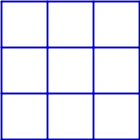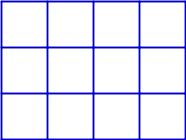A Puzzle Involving Squares
It is simpler than you think, but it took The Great Radar Oven ages.
Table of Contents
Problem
Part 1
Look at this 3 by 3 grid. How many squares are there?

Figure 1: Hint: It's not 9
Part 2
How would you get the squares for a 100 by 100 grid without counting them?
Find a general equation to model this.
Part 3
How would the equation change if the grid was not square, but rectangular instead?

Extensions
Cube
Using the prerious answers, what steps would be needed to find the square faces (both internal and external) of a 3D cube-shaped grid?
Cuboid
How about a cuboid-shaped grid?
Solutions
Part 1
14
That being:
- 9 squares of size 1 by 1
- 4 squares of size 2 by 2
1 square of size 3 by 3

Part 2
\[ f(x) = x^2 + (x-1)^{2} + (x-2)^{2} + ... + (x-x)^{2} \]
\[ x \geq 0 \]
Where \(x\) is the side length of the square grid.
For a 3 by 3 grid:
\[ f(3) = 3^2 + (3-1)^{2} + (3-2)^{2} + (3-3)^{2} = 9 + 4 + 1 + 0 = 14 \]
Part 3
\[ g(x,y) = xy + (x-1)(y-1) + (x-2)(y-2) + ... + (x-n)(y-n) \]
\[ x,y \geq 0 \qquad n = x;y \]
Where \(x\) is the grid length, and \(y\) is the grid width (or vice versa).
Extensions
Cube
\[ h(x) = 3(x+1) \times f(x) \]
\[ x \geq 0 \]
Where \(x\) is the side length of the square grid.
This function finds the amount of squares in one side of the cube, \(g(x)\) before multiplying this by \((x+1)\) to account for all the 'grids' in that plane, 4 for a 3 by 3 by 3 cube. Lastly, it multiplies by 3 to account for the three planes in a 3D space.
Cuboid
\[ i(x,y,z) = (z+1) \times g(x,y) + (y+1) \times g(x,z) + (x+1) \times g(y,z) \]
\[ x,y,z \geq 0 \]
Similarly to a cube, 3 dimensions means that there needs to be three statements. In this case they need to account for different lengths in each plane, requiring different combinations of \(x\), \(y\) and \(z\).
Function \(i\) finds the amount of squares in each rectangular side of the cuboid. It then multiplies each by the amount of those rectangles in the remaining plane.
Programming
Can You Program?
I pretty much exclusively write in Erlang, not the most readable language and not the most widely known (though it is undoubtedly important). If you think you are able to write a program that does the same thing in a different language, then I would greatly appreciate your help.
Get in contact with me here.
Python 3 (By Jonas/Strata)
Many thanks to Jonas who runs Strata's Place!
I would highly recommend looking at their superb site!
Here is the original code.
Interpret with: python3 puzzle.py
def validate_inputs(func): # This is a decorator to check the function's # arguments for negative values. In case of a # negative value, a ValueError will be raised. def validator(*args): for param in args: if param < 0: raise ValueError("parameter %d is smaller than 0!" % param) return func(*args) return validator @validate_inputs def square(x): # Doing it like this is probably not the most # resource-efficient way, but I wanted to # demonstrate the elegance of Python. return sum([(x-i)**2 for i in range(x)]) @validate_inputs def rectangle(x, y): return sum([(x-i)*(y-i) for i in range(min(x,y))]) @validate_inputs def cube(x): return 3*(x+1)*square(x) @validate_inputs def cuboid(x,y,z): return (z+1) * rectangle(x,y) + (y+1) * rectangle(x,z) + (x+1) * rectangle(y,z) print(square(3)) print(rectangle(3, 4)) print(cube(3)) print(cuboid(3,4,5))
C (C99) (By Jonas/Strata)
I am once again indebted to "Strata's Place"'s Jonas!
Their superb site is still very much superb.
Here is the original code.
Compile with: gcc puzzle.c -o puzzle -std=c99 -Wall -pedantic
#include <stdio.h> #define POWER2(x) ((x)*(x)); #define MIN(x,y) ((x) < (y) ? (x) : (y)) int square(int x) { if (x < 0) { return -1; } int result = 0; for (int i = 0; i < x; i++) { result += POWER2(x-i); } return result; } int rectangle(int x, int y) { if (x < 0 || y < 0) { return -1; } int result = 0; for (int i = 0; i <= MIN(x,y); i++) { result += (x-i)*(y-i); } return result; } int cube(int x) { if (x < 0) { return -1; } return 3 * (x+1) * square(x); } int cuboid(int x, int y, int z) { if (x < 0 || y < 0 || z < 0) { return -1; } return (z+1) * rectangle(x,y) + (y+1) * rectangle(x,z) + (x+1) * rectangle(y,z); } int main() { printf("%d\n", square(3)); printf("%d\n", rectangle(3,4)); printf("%d\n", cube(3)); printf("%d\n", cuboid(3,4,5)); return 0; }
Erlang (By FonnD)
Compile with: erlc squares.erl
Run with: exec erl squares
-module(squares). -export([square/1,rectangle/2,cube/1,cuboid/3]). square(X) when X>=0 -> %X = # of sides square(X,0). %S = # of squares square(0,S) -> S; %when X==0 output S square(X,S) -> %else square(X-1,S+(X*X)). %X=(X-1), S+=X^2 rectangle(X,Y) when X>=0;Y>=0 -> rectangle(X,Y,0). rectangle(X,Y,S) when X==0;Y==0 -> S; %could pattern match rectangle(X,Y,S) -> rectangle(X-1,Y-1,S+X*Y). cube(X) when X>=0 -> (X+1)*3*square(X). cuboid(X,Y,Z) when X>=0;Y>=0;Z>=0 -> (Z+1)*rectangle(X,Y) + (X+1)*rectangle(Y,Z) + (Y+1)*rectangle(X,Z). do() -> io:write([squares:square(3) ,squares:rectangle(3,4) ,squares:cube(3) ,squares:cuboid(3,4,5)]).